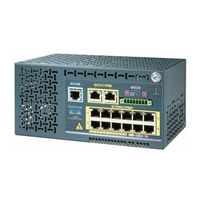Cisco WS-C2960S-24PD-L Ethernet Switch Manuals
Manuals and User Guides for Cisco WS-C2960S-24PD-L Ethernet Switch. We have 1 Cisco WS-C2960S-24PD-L Ethernet Switch manual available for free PDF download: Software Manual
Cisco WS-C2960S-24PD-L Software Manual (368 pages)
Software Guide
Table of Contents
-
Vtp
10 -
-
Device Icons
61-
-
Menu Bar62
-
-
-
Sys
64-
Toolbar67
-
-
Guide Mode72
-
Expert Mode72
-
-
Wizards72
-
Online Help73
-
Tool Tips73
-
-
Tac
76 -
-
-
-
Setting95
-
-
-
-
-
IP Addresses115
-
Host Names116
-
Passwords116
-
Management VLAN118
-
LRE Profiles119
-
NAT Commands119
-
Network Port119
-
-
Tac
105 -
-
-
Configuring CDP141
-
-
Configuring CGMP148
-
Configuring MVR155
-
Configuring STP161
-
Disabling STP162
-
STP Port States172
-
Configuring SNMP176
-
-
RADIUS Operation184
-
-
-
-
-
Configuring SPAN210
-
Disabling SPAN210
-
Enabling SPAN210
-
-
-
-
Overview224
-
-
-
Management Vlans225
-
Using VTP231
-
The VTP Domain231
-
VTP Version 2233
-
VTP Pruning234
-
-
Domain Names235
-
Passwords236
-
-
VTP Version237
-
-
Configuring VTP238
-
Monitoring VTP242
-
-
Troubleshooting267
-
-
-
Statistics268
-
-
-
Appendix
293 -
System Messages
293 -
-
-
AAAA Messages297
-
CDP Messages299
-
CHASSIS Message300
-
CMP Messages300
-
CPU_NET Message301
-
FRANK Messages302
-
IP Messages311
-
LRE CPE Messages312
-
MAT Messages314
-
MIRROR Messages315
-
MODULES Messages316
-
PM Messages317
-
PMSM Messages320
-
PRUNING Messages321
-
RAC Message325
-
RTD Messages326
-
SNMP Messages327
-
SW_VLAN Messages331
-
SYS Messages333
-
TAC Messages336
-
VTP Message341
-
-
I N D E X
343
Advertisement
